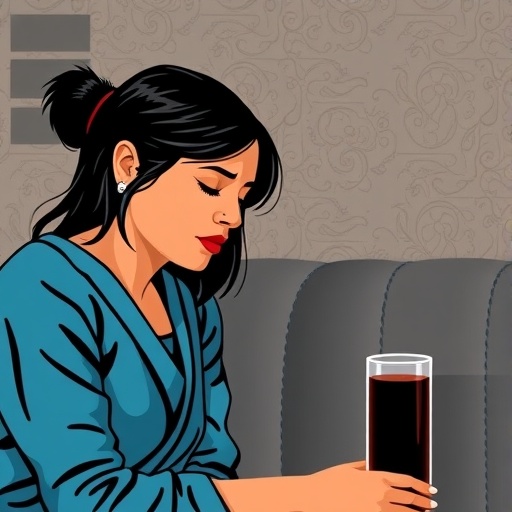A recent study published in BMC Psychiatry has shed new light on the intricate relationship between trauma and alcohol use among urban women in India, a demographic that has historically been underexplored in addiction research. With alcohol consumption rates rising among women globally—and a notable narrowing of the gender gap—this investigation reveals the profound psychological and socio-cultural dimensions that drive alcohol use disorder (AUD) in this population. The findings offer critical insights into the complex interplay of trauma, coping mechanisms, and social dynamics that contribute to escalating alcohol use in Indian urban contexts.
At the heart of the study is an exploration of how traumatic experiences intersect with drinking behaviors among women in India’s metropolitan centers. Employing a qualitative research methodology, the investigation involved in-depth interviews with thirteen heterosexual women aged 18 to 55, all clinically diagnosed with AUD. This sample offers a unique lens into an often-overlooked subset of urban Indian society whose alcohol-related struggles remain shrouded in stigma and limited public discourse. Through an Interpretive Phenomenological Analysis approach—a technique that emphasizes subjective lived experiences—the researchers sought to understand both the motives and contextual triggers behind alcohol consumption.
One of the critical revelations from the study highlights the centrality of trauma and stress as fundamental drivers for these women’s alcohol use. Many participants disclosed histories of physical, emotional, or relational trauma, with alcohol serving as a primary method to self-medicate psychological pain. This nexus between trauma and substance use reflects global trends observed in trauma-informed models of mental health, where alcohol is often a maladaptive coping strategy for managing unresolved distress and emotional burdens. For urban Indian women, whose social roles and expectations may compound feelings of isolation or helplessness, alcohol can initially offer a sense of relief or temporary escape.
In addition to trauma, the research vividly underscores the role of external stressors such as financial difficulties, bereavement, and marital discord in exacerbating alcohol use. These stressors not only trigger initial drinking episodes but also sustain prolonged consumption by perpetuating a cycle of emotional turmoil and dependency. The findings articulate how systemic issues—economic marginalization, precarious domestic circumstances, and lack of social support networks—intersect with personal trauma, creating a multidimensional framework that complicates recovery efforts.
Crucially, the study also explores significant barriers to accessing help among these women. Social stigma, gendered views on addiction, and limited availability of gender-specific treatment services emerge as critical obstacles that impede engagement with formal health systems. These barriers contribute to a pervasive invisibility of women’s substance use issues and restrict access to trauma-informed interventions, which are pivotal for addressing the root causes of addiction rather than merely managing symptoms. The participants’ narratives reveal a pressing need for culturally sensitive, gender-responsive treatment paradigms.
This work directly aligns with the United Nations Sustainable Development Goal 3, which emphasizes good health and well-being, particularly in addressing mental health and substance use disorders. The researchers advocate comprehensive care models that incorporate trauma-informed principles, tailored specifically to the sociocultural reality of urban South Asian women. Such models would recognize the intersectionality of trauma, gender, and addiction, promoting holistic healing rather than fragmented treatment.
Moreover, the study calls attention to the significance of recognizing co-dependency and its relationship with trauma in the context of alcohol use. Women’s relational dependencies, often influenced by experiences of abuse or neglect, can entangle with their substance use patterns, complicating the trajectory of addiction and recovery. These insights necessitate that treatment frameworks expand beyond traditional abstinence models to include psychotherapeutic interventions addressing trauma and interpersonal dynamics.
The implications of this research are vast, particularly for public health policy and clinical practice. By emphasizing trauma’s pivotal role in women’s alcohol use, it challenges existing paradigms that may underestimate the depth of emotional and social complexity underpinning AUD in this group. Policy interventions that integrate mental health services with addiction treatment—grounded in trauma awareness and gender sensitivity—could transform outcomes for countless women struggling silently within urban India.
Importantly, this study also opens avenues for further research into the nuanced ways culture, gender, and trauma intersect to influence substance use. Urban Indian women face unique pressures derived from rapidly evolving social norms, economic transitions, and persistent patriarchal structures. Understanding these dynamics is essential for designing prevention and intervention strategies that resonate locally and offer sustainable support systems.
The investigation’s qualitative design, while limited in sample size, provides a richly textured understanding of individual experiences. It captures the complexity of trauma-alcohol linkages through participants’ voices, offering poignant, firsthand testimonies that quantitative metrics might overlook. This methodological choice underscores the value of phenomenological approaches in capturing the depth of psychological phenomena associated with addiction.
As alcohol consumption among women continues to rise worldwide, studies like this highlight an urgent global health challenge shaped by local cultural specificities. The narrative of trauma and coping illuminated in urban Indian women reflects a broader pattern, demanding a reimagined framework for addiction treatment—one that privileges empathy, cultural context, and gender dignity.
In conclusion, the profound insights provided by this study emphasize the necessity for trauma-informed, gender-specific interventions to better support urban Indian women grappling with alcohol use disorder. These women’s stories reveal how pain and pleasure intertwine, prompting both suffering and momentary solace in alcohol’s embrace. Addressing the root causes—psychological, social, and cultural—holds the key to unlocking pathways toward healing and sustained recovery.
Subject of Research: The study investigates the relationship between trauma and alcohol use among urban Indian women diagnosed with Alcohol Use Disorder, focusing on the psychological, social, and cultural factors influencing their consumption patterns and recovery barriers.
Article Title: Navigating pain and pleasure: trauma and alcohol use among urban women in India
Article References:
Balsarkar, K., Mazumdar, K. Navigating pain and pleasure: trauma and alcohol use among urban women in India. BMC Psychiatry 25, 961 (2025). https://doi.org/10.1186/s12888-025-07326-w
Image Credits: AI Generated




